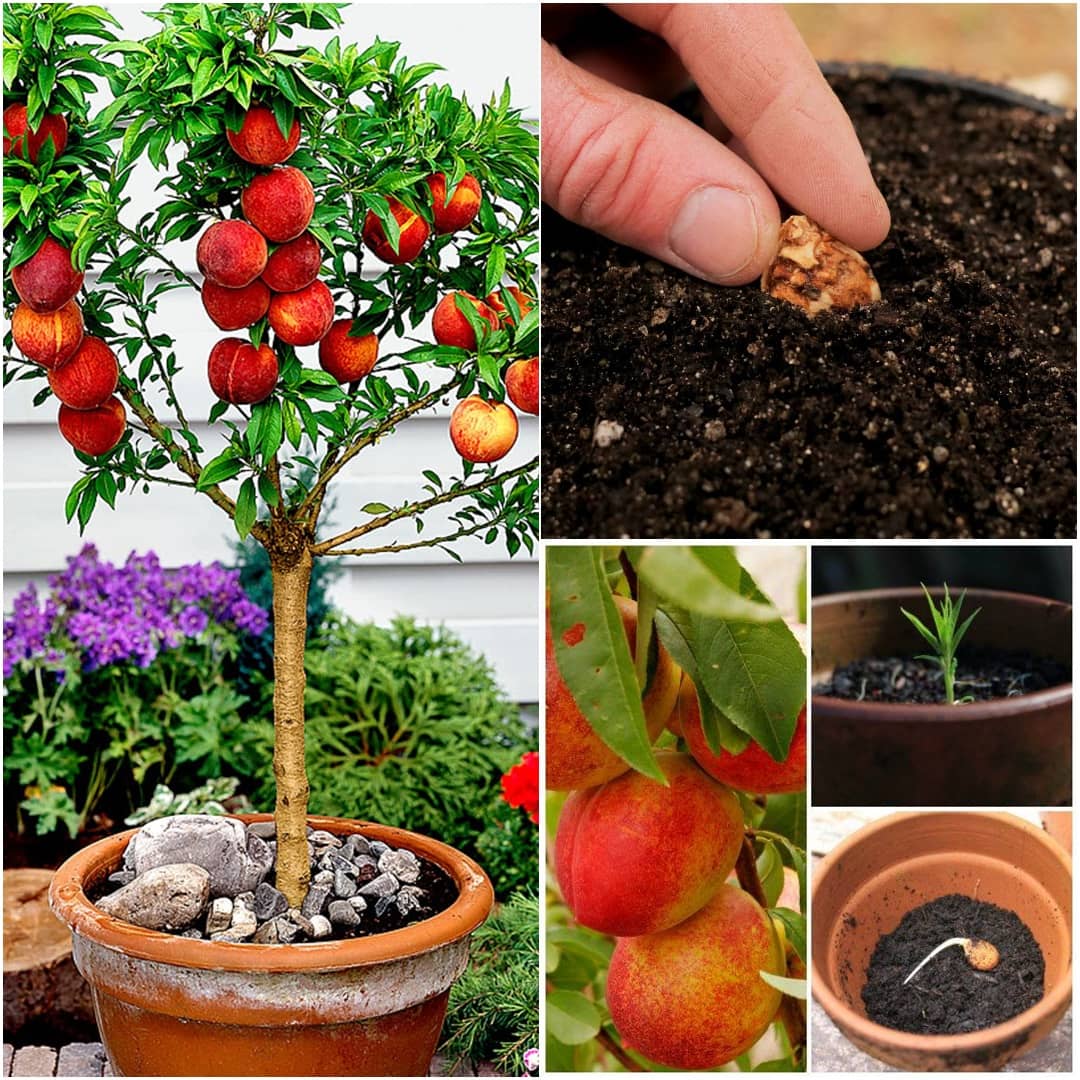If you’ve ever dreamed of harvesting juicy, fresh peaches right from your own home, you’re not alone! Growing a peach tree indoors from seed may sound like a challenging task, but with the right knowledge and care, it’s absolutely achievable. Not only does it give you the satisfaction of growing your own fruit, but it also adds a beautiful, vibrant touch to your indoor space.
In this step-by-step guide, we’ll walk you through everything you need to know about growing a peach tree indoors from seed. From selecting the right peach variety to ensuring proper care throughout the year, we’ll cover all the essentials to help you successfully nurture your very own indoor peach tree.
Why Grow a Peach Tree Indoors?
Benefits of Indoor Gardening
Indoor gardening has been growing in popularity for years, and for good reason. Whether you’re dealing with limited outdoor space, living in a cold climate, or simply want to enjoy fresh fruit year-round, growing fruit indoors offers numerous benefits:
- Year-Round Freshness: Growing a peach tree indoors means you can enjoy fresh peaches regardless of the weather outside. Whether it’s snowing in the winter or too hot in the summer, your indoor peach tree can thrive year-round with proper care.
- Space Efficiency: Not everyone has a large garden or backyard. But that doesn’t mean you can’t grow your own fruit. With the right container and care, you can grow a dwarf peach tree indoors in just a small corner of your home or on a balcony.
- Aesthetic Appeal: Peach trees are beautiful! Their delicate blossoms and lush green foliage add charm to any room, making them a perfect addition to your indoor garden.
- Control Over Growing Conditions: Indoors, you have full control over temperature, humidity, water, and light, which means you can avoid the pests, disease, and extreme weather conditions that outdoor trees often face.
Which Peach Tree Varieties Are Best for Indoor Growing?
When choosing a peach tree variety for growing indoors, you need to consider size, fruiting potential, and adaptability to container life. While many peach trees can be grown in pots, some varieties are better suited for indoor growing than others:
- Dwarf Peach Trees: These are perfect for indoor gardening due to their compact size. Varieties like Bonanza, Pixzee, and Nectar are ideal for containers and can thrive indoors. Dwarf peach trees typically grow to a height of 3 to 4 feet, making them manageable for indoor spaces.
- Semi-Dwarf Peach Trees: If you have more space, semi-dwarf varieties like Garden Gold and Golden Glory can be a good choice. These trees grow larger than dwarf varieties but can still be pruned to fit within a reasonable indoor space.
Choosing the Right Peach Seed
When starting your peach tree indoors, you have two main options: purchasing seeds or using the pit from a fresh peach. Both approaches are viable, but each has its pros and cons.
- Store-Bought Seeds: You can purchase peach seeds from a nursery or online gardening store. These seeds often come from specific, desirable varieties, so you can select a tree that suits your taste and growing conditions. However, keep in mind that store-bought seeds might not always be as fresh or viable as those from a peach you’ve just eaten.
- Peach Pits: Using the pit from a peach you’ve eaten is a great way to start your own tree from scratch. However, it requires more effort to extract and prepare the seed. The benefit is that you know the peach’s quality and taste, and you’re essentially recycling the fruit you’ve already enjoyed.
Preparing Peach Seeds for Germination
Before you can plant your peach seed, you need to prepare it properly. Peach seeds are not as straightforward to germinate as other common houseplants, but with a little patience and the right techniques, you can get your seeds ready for planting.
Step 1: Clean the Seed
First, you need to extract the seed from the peach pit. Carefully crack the pit open using a nutcracker or hammer, taking care not to crush the seed inside. Remove any leftover fruit or flesh from the seed and clean it thoroughly with water. This ensures that there are no remnants that could cause mold or rot during the germination process.
Step 2: Scarify the Seed
Peach seeds have a hard outer shell that prevents them from sprouting right away. To help the seed germinate faster, you’ll need to scarify it. This means slightly damaging the outer shell to allow moisture to penetrate the seed. You can do this by gently rubbing the seed against a piece of sandpaper or using a file to scratch the surface. Be careful not to damage the actual seed inside.
Step 3: Cold Stratification
Peach seeds require a period of cold stratification, which mimics winter conditions and prepares the seed for spring. To stratify your peach seed:
- Wrap the seed in a damp paper towel or a piece of cloth.
- Place it in a plastic bag to maintain moisture.
- Refrigerate the bag for 6 to 8 weeks. This cold period is essential for breaking the seed’s dormancy.
This process is crucial for germination, so don’t skip it. During this time, you’ll want to check the seed every week to ensure that it stays moist but not overly wet.
Planting Peach Seeds Indoors
After the stratification process is complete, it’s time to plant your peach seed. Choosing the right container, soil, and planting technique is key to success.
Choosing the Right Container
Peach trees, even dwarf varieties, need plenty of space for their roots to grow. Choose a container that is at least 6 to 12 inches in diameter with good drainage holes to prevent root rot. If you’re starting multiple seeds, choose a slightly larger pot to accommodate them all.
If you plan to eventually transplant the tree outdoors, consider using a container that will accommodate the tree for at least a year or two.
Best Soil for Planting Peach Seeds
Peach trees thrive in soil that is well-draining and slightly acidic, with a pH of 6.0 to 7.0. A mix of potting soil and sand or perlite is ideal for promoting good drainage. You can also add some compost to enrich the soil and provide nutrients to your seedling.
When filling your container with soil, make sure to leave about an inch of space at the top to allow room for watering.
Planting Depth and Spacing
Plant your peach seed about 1 to 2 inches deep into the soil. If you’re planting multiple seeds in one pot, space them at least 2 inches apart to prevent overcrowding as they grow.
Once your seed is planted, water it lightly to ensure the soil is evenly moist, but not soaked.
Caring for Your Indoor Peach Tree
Once your peach tree seed starts to sprout, it’s time to focus on providing the right care to help it grow strong and healthy.
Lighting Needs for Indoor Peach Trees
Peach trees require at least 6 to 8 hours of sunlight each day. If your home doesn’t receive enough natural light, you can supplement it with grow lights. These special lights mimic the natural spectrum of sunlight and help promote healthy growth. Position the grow light about 6 to 12 inches above the tree and keep it on for 12 to 16 hours a day.
Temperature and Humidity
Peach trees prefer temperatures between 65°F and 75°F (18°C to 24°C). Keep the tree in a location where temperatures remain stable. Avoid placing it near heat sources like radiators or air conditioners, as this can cause temperature fluctuations that can stress the plant.
Peach trees also need moderate humidity levels. If the air in your home is too dry, especially during winter, you can increase humidity by placing a tray of water near the tree or using a small humidifier.
Watering Your Peach Tree
Peach trees like consistent moisture, but they don’t tolerate sitting in water. Water the tree when the top inch of soil feels dry to the touch, and ensure that the pot has proper drainage to prevent root rot. Be careful not to overwater, as this can lead to mold and fungal problems.
Troubleshooting Common Problems
Pests and Diseases
While indoor peach trees are generally safe from many outdoor pests, they can still attract aphids, spider mites, and mealybugs. Regularly inspect your tree for pests and treat them promptly with natural solutions, such as neem oil or insecticidal soap.
Why Your Peach Tree Might Not Produce Fruit
If your tree is healthy but not producing fruit, it may be due to insufficient pollination. Peach trees require cross-pollination to produce fruit, which means they need pollen from another peach tree. If you’re growing a single tree, you may need to help pollinate it manually by using a small brush to transfer pollen from one flower to another.
FAQs
Do peach seeds need to be dried before planting?
Yes, peach seeds should be dried before planting. After removing the seed from the peach pit, let it air dry for a few days. Once dry, you’ll need to stratify the seed, which involves exposing it to cold temperatures to mimic winter conditions. This step is crucial for germination. You can place the seed in a damp paper towel inside a plastic bag and store it in the refrigerator for 6-8 weeks before planting.
How to get a peach seed out of the pit?
To extract the peach seed from the pit, follow these steps:
- Dry the pit for a few days to make it easier to crack.
- Use a nutcracker or a hammer to gently crack open the hard shell of the pit. Be cautious to avoid damaging the seed inside.
- Once cracked, carefully remove the inner seed. It’s this seed that can be planted or stored for later use.
How to grow a peach tree from a cutting?
To grow a peach tree from a cutting, follow these steps:
- Cut a 6-inch section of new growth from a healthy peach tree.
- Remove the lower leaves from the cutting, leaving a few at the top.
- Place the cut end in 3 inches of water or dip it in rooting hormone and plant it directly into a well-draining potting mix.
- Keep the cutting in a warm, sunny location or under grow lights. If using water, change it every few days.
- After 4-6 weeks, roots should begin to form, at which point the cutting can be transplanted into a larger container for continued growth.
Conclusion: Enjoy the Fruits of Your Labor
Growing a peach tree indoors from seed is a rewarding and fulfilling process. While it requires patience and careful attention to detail, the satisfaction of nurturing a fruit tree in your own home is well worth the effort. Whether you’re looking for fresh fruit, beautiful greenery, or simply a fun gardening project, an indoor peach tree can bring joy to your space.
Start your peach tree today, and in a few years, you may just be enjoying the sweet fruits of your labor!


